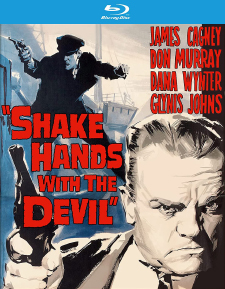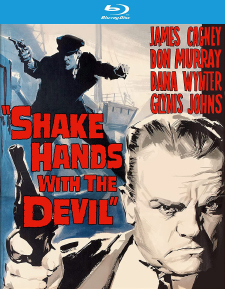Shake Hands with the Devil (Blu-ray Review)

Director
Michael AndersonRelease Date(s)
1959 (January 4, 2022)Studio(s)
United Artists/MGM (Kino Lorber Studio Classics)- Film/Program Grade: B+
- Video Grade: B
- Audio Grade: B
- Extras Grade: C
Review
Set in Dublin in 1921, Shake Hands with the Devil stars James Cagney as an Irish professor practicing and teaching surgery during the bloody conflict between Great Britain and Ireland. American war veteran and medical student Kerry O’Shea (Don Murray, Bus Stop), studying in Ireland under the renowned Professor Lenihan (Cagney), gets drawn into the violent struggle between the Irish Republican Army and the British mercenaries known as the Black and Tans. Kerry repeatedly turns down pleas from fellow students to join their secret IRA cell, saying that he saw enough bloodshed in World War I.
When his good friend Paddy Nolan (Ray McAnally) gets shot by the Brits, Kerry sees that only an expert surgeon can save Paddy’s life. Prof. Lenihan shows up and it turns out he’s also an IRA leader, a Jekyll/Hyde character who saves lives as a surgeon but doesn’t hesitate to snuff them out when it furthers the cause. Burning with rage, he will show no mercy and accept no compromise until Ireland becomes a republic.
After witnessing many atrocities committed by the brutal British occupiers known as the Black and Tans, and after he himself is wrongly imprisoned and tortured by a sadistic officer, Kerry commits to the cause. Still, he’s torn between the justice of the cause and the ruthless methods employed to achieve its goals, so there’s some attempt to view both sides of the issue, though the script is definitely biased toward the IRA.
An elderly woman, Lady Fitzhugh (Sybil Thorndike), is arrested and sentenced to two years in prison for abetting the escape of an IRA fugitive. In protest, she goes on a hunger strike. Lenihan figures that by kidnapping Jennifer Curtis (Dana Wynter, Invasion of the Body Snatchers), daughter of a British dignitary, an exchange of prisoners can be effected.
Though Cagney received top billing, Don Murray is actually the lead. His character’s vacillation in the beginning is understandable, since the First World War saw millions dying not only from gunfire but also from infection. We accept that he wants no part of more violence. But Murray is a lightweight actor who offers little nuance in his performance. He never seems engaged in the narrative—a spectator in his own film.
Cagney, though not terribly believable as a surgeon, is excellent as the IRA leader. Tough, dedicated, and willing to go to any lengths to get rid of the British, Lenihan is a force to be reckoned with. His men are loyal, rallied by his strength and sheer guts. Unafraid to risk his life, Lenihan is tunnel-visioned. Nothing is as important as the cause, and this is his Achilles heel. In the grip of such incendiary political passion, he’s no longer a freedom fighter, but a nearly mechanical agent of destruction.
Director Michael Anderson (Around the World in 80 Days) filmed Shake Hands with the Devil on location in Ireland. Cagney’s performance carries the picture. He’s terrific, and he infuses the character of Lenihan with elements of the gangster roles he played in Warner Bros films of the 1930s and 40s. First-rate supporting performances by Cyril Cusack, Michael Redgrave, Glynis Johns, and Richard Harris add to the film’s appeal.
The script by Ivan Goff and Ben Roberts, based on the novel by Rearden Conner, clearly depicts the enmity between the IRA and the Black and Tans, but gives little backstory to illuminate the causes of this hatred. A budding romance between Kerry and Jennifer is completely contrived and seems tacked on to please female audience members. Action scenes graphically show bombings and killings.
Shake Hands with the Devil was shot by director of photography Erwin Hillier on black-and-white 35 mm film, finished photochemically, and presented in the widescreen aspect ratio of 1.66:1. Kino Lorber’s Blu-ray is sourced from a 2K master. Interiors feature deep shadows on sets and often obscure half of the characters’ faces, providing an eerie look. An outdoor night scene features glistening cobblestone streets having been given a water coating to reflect light and cast dramatic reflections. A beach scene and a climactic scene atop a hill take place under an overcast sky with no hint of sunshine. Blacks are not as deep and rich as in other Blu-ray releases of older films, tending to look a bit washed out. The women are attractively lit, giving their complexions a warm glow.
The audio is included in English 2.0 mono DTS-HD Master Audio. English SDH subtitles are an available option. Dialogue is clear and precise throughout. Of the Irish characters, only Cagney and Harris speak with a brogue. Sound effects include explosions and gunfire. Sound mixing is particularly effective in a dock scene, in which dialogue, ambient noise, and the sound of a crane loading baggage are nicely blended. The score by William Alwyn adds excitement to the action scenes and is used sparingly in the rest of the film, coming in only occasionally to underscore dramatic moments.
Bonus materials include the following:
- Interview with Don Murray (8:21)
- Trailer (2:17)
- Never Steal Anything Small (1:57)
- The Gallant Hours (2:50)
- One, Two, Three (2:11)
- No Highway in the Sky (2:10)
Murray discusses his theatrical career and notes that he was offered a number of parts in movies but accepted none until he was offered Bus Stop opposite Marilyn Monroe. He discusses the Method style of acting, in which the actor experiences the emotions the character is feeling. Michael Anderson was not overly specific in his direction; he set up the scene and allowed the actors their creative freedom. It was great working with James Cagney, who was from “the old school of acting.” Off stage, between takes, Cagney would dance to keep in shape. Firearms used in the film had to be carefully returned so they wouldn’t wind up in the hands of the IRA. Some British people were unhappy with the film because it was sympathetic to the IRA. Murray concludes the interview with the comment, “It was a very satisfying experience.”
Shake Hands with the Devil is a late-career success for James Cagney. Intense and filled with indignant rage, he commands the screen. Though good in its own right, the film would be less interesting without his presence. It’s great to watch a master display his craft. He’s as good in this film as he was years earlier in White Heat or Public Enemy. Our view of terrorism in the wake of 9/11 may have dulled sympathy for Lenihan and his followers, but the film still works as an action/political thriller.
- Dennis Seuling

